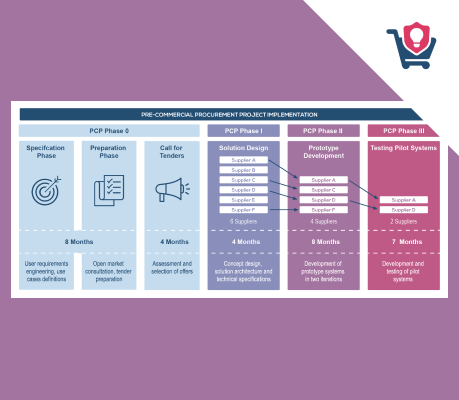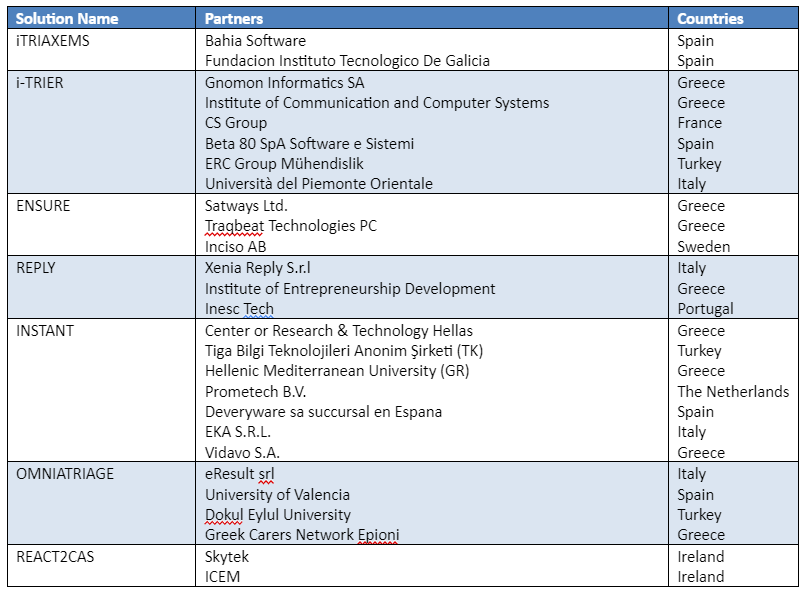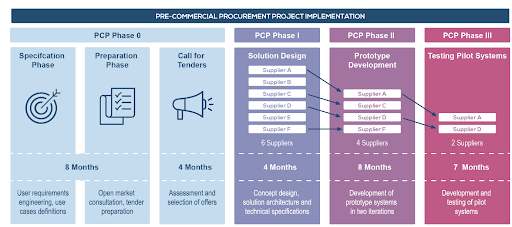
iProcureSecurity PCP: Implementation of Phase 1 – Solution Design.
Following the launch of the Call for Tenders, the iProcureSecurity PCP project awarded seven Contractors to the Phase 1 – Solution Design. The contractors are implementing the overall architecture of the solutions, following the technical specifications provided by the project consortium. The implementation of Phase 1, started in October 2022 and end in January 2023.
Overview
For the Phase 1 “Solution Design”, a total of fifteen bids have been received and evaluated during the Call for Tenders process, and seven of them have been officially awarded for Phase 1 “Solution Design”.
Although the project was planning – following the Pre-Commercial Procurement procedure – to award six bids only, one more has been accepted as awarded contractor, enabling more solutions to be developed, and thus, fostering more innovation!
All the accepted bids are built up by national or international consortia, counting 27 organisations from 7 different countries.
Phase 1 runs from October 2022 until January 2023.

About the Phase 1
During this phase, the awarded R&D providers are asked to develop an overall conceptual architecture and technical specifications for each of the system components and their interfaces based on the requirements, use cases and service process models. A series of deliverables will be submitted in order to evaluate the progress based on a predefined set of criteria.
The bids which have been awarded to the Phase 1 Solution Design are asked to develop an overall conceptual architecture and technical specifications for each of the system components, as well as for their interfaces. The Solution Design is based on the requirements, use cases and service process models provided in the Call for Tenders. A series of deliverables will be submitted in order to evaluate the progress, based on a predefined set of criteria.
The Phase 1 “Solution Design” lasts 4 months (October 2022 to January 2023), and it will be followed by a second evaluation of the results, allowing only 4 bids to continue the R&D.
The design of the solutions is based on the previous research conducted within the project, which outlined the importance of:
- Stronger coordination and engagement of local key actors is at the core of an improved approach,
- Mass Casualty Incidents (MCIs) often cross the national borders and require an efficient and effective cooperation among countries and institutions. Thus, transnational cooperation has been identified as an essential component of properly managing MCIs,
- Lastly, innovative and disruptive technologies must be developed and customised to the specific needs of the actors involved, facilitating the cooperation of the field, the communication among the wide range of stakeholders involved in the MCI and supporting the decision-making process of the EMS, in order to react quickly and efficiently during the disaster.
Preliminary Results & Abstracts
In the Phase 1 of the project, the iProcureSecurity PCP team has made major progress towards the implementation of the action foreseen by the Description of Action, evaluating 15 bids, awarding seven contractors, and following up with their work and implementation. The abstract of the solutions prepared as publicly available part of the work implemented by the suppliers, are below:
iTRIAXEMS: The iTRIAXEMS solution aims to address the challenges faced by European Emergency Medical Services in mass casualty events when it comes to improving triage practices, resource allocation, decision making, availability, security, and data protection in a crisis management context. In response to this challenge, we propose the development of a cloud platform which combines software and hardware components that will allow to go a step beyond the current state of the art, due to the application of innovative technologies and functionalities, such as Triage Tag Devices, Drones, Artificial Vision, or AI technologies. The execution of the project will be based on agile methodologies, co-design strategies, and the active involvement of qualified experts. We expect the development of iTRIAXEMS to have a major impact on victims and procurers, and to reduce the number of fatalities and serious sequelae when a mass-casualty incident is declared.
i-TRIER: I-TRIER brings as a legacy one of the very first fully digitized Triage Solutions, widely adopted Crisis Management System and Computer Aided Dispatch systems and a unique toolkit of Hospital Management Systems providing interoperability solutions for unifying Emergency and Victim Tracking data domains with the health-data related ones. i-TRIER brings also to the forefront the citizens through the management of their PHR and by securely providing access to it by EMS. A modular, open, interoperable yet strongly integrated solution will be provided, through advancements in existing functionalities both in hardware and software components. i-TRIER will establish a flexible interoperability framework through an efficient streaming mechanism and local exchange of information. Towards the design and testing of the i-TRIER solution, the technology providers will be supported by experts throughout its development stages, ensuring that KPIs related to the MCI response will be improved.
ENSURE: ENSURE system aims at strengthening the response of Emergency Medical Services (EMS) and Responders (EMR) to Mass Casualty Incidents (MCIs). The latter are called to operate under stressful and uncertain environments, given that MCIs are usually evolved in complex and confusing situations. In the first phase of the project, the consortium is designing a novel digital triage system by utilizing the unique expertise of Satways, Traqbeat and Incisio. By leveraging hands on experts’ experience in emergency medicine (Incisio), the project will combine medical wearables (Traqbeat) with emergency management system (Satways) into a novel digital triage system for MCIs. In a disaster event, the system will enable the quick prioritization of those who need high medical attention by automatically recognizing and continuously monitoring their vital signs via an attachable patch from the disaster location to the hospital.
Reply: Reply for Innovative SCenario in Emergency Development – Design and build an MCI management solution, integrated with external EHR systems to speed up and outperform the continuous handover process of data collection and sharing required from the beginning of the triage process until the hospitalization of the casualties. In order to support the different actors in this process the platform will include the digitalization of procedures and algorithms already in use in MCI management enhanced by a decision support system and by the exploitation of AI/ML modules. The solution will include a “Digital Triage Tag” composed of a smartphone and wearable devices to enable the collection of vital parameters in real-time to build the profile of the casualties and inform their state of severity along the process. The solution is built to support different types of roles and stakeholders of the system and it’s designed to ensure a high level of configurability for each profile. The architecture proposed aims to build a resilient, performing, safe and interoperable platform and will be deployable in a hybrid, cloud-based or on-premises environments, so that it can be easily replicable across different geographic regions.
INSTANT: INSTANT aims to rectify the fragmentation between civilian and military triage systems by i) analysing the strengths and weaknesses of each system currently in use throughout Europe and ii) proposing and designing a unified and modular Triage system, able to adapt to local needs and regulations in place. Identifying and analysing each system will be performed via a systematic search of the international literature using defined keywords and outcome variables, and locally by in-person interviews of medical professionals working at various hospital settings in European countries. Outcome variables such as survivability, need for hospitalization, cost per patient, etc., will be also recorded, analysed and used to define strengths and weaknesses of each Triage system. In addition to classic statistical tools for reviews (forest plots, ANOVA, and so on), data obtained will be modelled using graph database technologies in order to help recording and analysing the complex relationships of the data sets in a more flexible manner.
OMNIATRIAGE: OMNIATRIAGE will deliver a comprehensive solution for mass casualty incident management, based on the OMNIACARE system created by eResult, to support coordinate and efficient rescue operations. Easy tracking and geolocation of each casualty, continuous flow of data in real time about their conditions and advanced data visualization system will constitute some of the main features of the solution, to sustain the management of the medical site on the field. OMNIATRIAGE will further provide support to operations center work, helping to manage human and vehicle resources, thanks to a continuous exchange of data between MCI sites, hospitals, rescue services and control rooms, to optimize the response of the rescuers in critical situations. The solution is designed to be easily implemented to every kind of system in use, thanks to its inherent interoperability and the modular structure that allows high performance and adaptability in different situations and environments.
REACT2-CAS: REACT2-CAS is an innovative, modular and flexible triage management system aimed at increasing the effectiveness and efficiency of EMS services. The system is designed to facilitate the coordination of EMS Services and other partner emergency services, at local, regional, national and transnational levels. REACT2-CAS provides the full functions of a single integrated command-and-control centre in a distributed way: it provides all the key services with the required IT system to support and facilitate effective coordination, communication, decision making and action management, at each level of management or command personnel. REACT2-CAS is deployed as a series of distributed cloud-based services that are accessible via the standard communication infrastructures, i.e., Internet and mobile networks, as well as future systems such as 5G and SatComms. The solution presented comprises of the following eight main components:1. Central information system (CIS)2. electronic Triage Tag3. Data visualisation system (DVS)4. Advanced Medical Site Management5. Clinical Parameters Collection System 6. Operation Site Management7. Vehicle and Resource Management 8. Evaluation and Training.
Next Steps
The Phase 1, which ends in January 2023, will be followed by the Phase 2 – Prototype Development.
Qualified contractors will develop and test prototypes in two iterations. The first iteration (v1) aims at developing non- or partly functional prototypes of key systems components. Test outcomes will be collected and analysed for design, to serve as input for the suppliers’ development of the second iteration (v2). Outcomes of v2 prototype testing will also be used for the evaluation of the phase outcomes. The image below shows the overall structure of the different project phases, as well as the competitive process for the contractors.

More information on the next phases will be available in the next articles.
Stay updated, subscribe to the iProcureSecurity PCP Newsletter
Keywords
Pre-Commercial Procurement, PCP, Triage Management Systems, Emergency Medical Services, Solution Design, Call for tenders Results, Innovation Needs, Innovation Procurement, Disaster Management, Technology, Innovation.

